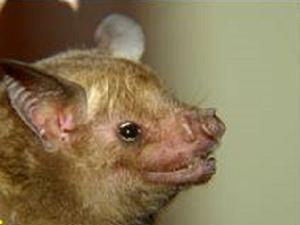Carlos Alberto Mancina
Other projects
19 Jun 2009
Effects of Hurricanes on Bat Populations in the “Sierra del Rosario” Biosphere Reserve, Cuba: A Long-Term Monitoring Study
9 Feb 2012
Integrating Research and Education for the Conservation of Cuban Bats and their Habitats
The aims of this project is to execute surveys in protected areas and localities little surveyed or unsurveyed for bats and to produce a National Conservation Action Plan for Cuban Bats.

Cuban fruit-eating bat (Brachyphylla nana).
Most Cuban bat species are under some form of threat. The major threats to their survival are associated with destruction of forests and alteration/disturbance of caves, the latter being critical habitats for the mostly cave-dwelling Cuban bat fauna. Cuba’s Red-List includes four bat species; however, at least 10 species could be susceptible to local extinctions due to their high roost specialization in hot-cave environments. The most recent synopsis on the distribution of Cuba’s bats is now 35 years old, and the best available maps showing species have large areas without any information. Our analysis of the Management Plans for 45 of the most important protected areas in Cuba revealed that 70% do not have bat presence records for the areas.

Greater funnel-eared bat (Natalus primus).
We will conduct “intensive bat” surveys in un-surveyed protected areas and other localities previously identified for high potential species richness, but unconfirmed or with deficient information. We will combine sampling with mistnetting, acoustic surveys, and counts in caves, including indirect approaches, such as examining remains in pellets of barn owls. Our project will generate an updated, geo-referenced catalogue of the main bat caves (including the most important hot caves) as well as protection and conservation status of these roosts and surrounding habitats. This project will constitute the most intensive approach to documenting the distribution of Cuba’s bats in the last 40 years; these data would support new assessments of the threat status of Cuba’s bats. The Latin American and Caribbean Bat Conservation Network (RELCOM) has already recognized four Important Areas for Bat Conservation on Cuba; however, this project could set a baseline for helping to identify other important sites and areas for bat conservation. This project will also provide the necessary resources to allow the Program for Conservation of Cuba’s Bats (PCMCu) to consolidate and integrate stakeholders and conservation practitioners in bat conservation throughout Cuba. During the project, we will build local capacity and general bat awareness through educational activities and technical training events.
Through meetings with national experts on the study of bats, members of PCMCu, students, and representatives of the Protected Areas of Cuba, we will evaluate local experiences, conservation problems, threats and information gaps. During these meeting, the threat status, using criteria developed by IUCN, of Cuba’s bats will be reevaluated. The results of these meetings will be integrated in a national meeting where the final draft of the Conservation Action Plan for Cuban bats will be crafted.